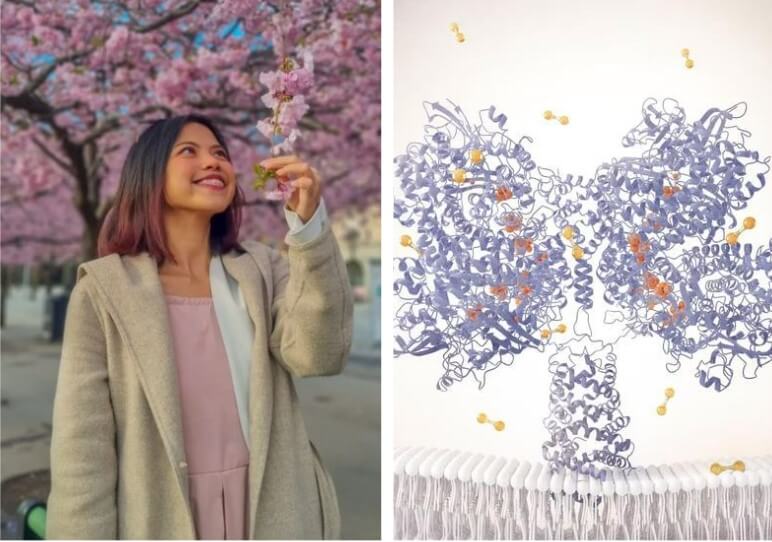
In a landmark study that has the potential to redefine the future of sustainable energy, Filipino Ph.D. scholar Princess Cabotaje of Uppsala University has played a pivotal role. She has contributed to the discovery of a unique biological process that enables microorganisms to extract “energy from thin air”.
This remarkable breakthrough, reported in the journal Nature, could be a game-changer in reducing the world’s dependence on fossil fuels. This research conducted by an international team including Cabotaje, illuminates a previously unknown pathway that microorganisms use to extract hydrogen from the atmosphere.
A Cebu City native, the 28-year-old Cabotaje is a distinguished academic, having graduated Cum Laude with a degree of BS in Chemistry from the University of the Philippines Diliman. She later earned her Master’s degree from the University of San Carlos before embarking on her Ph.D. journey in Chemistry at Uppsala University in Sweden. Throughout her academic career, Cabotaje has received numerous accolades, including representing the National Schools Press Conference (NSPC) and winning the Journalist of the Year award during her school years.
But her commitment to the world of academia extends beyond her personal achievements. As a mentor at GradMAP Philippines which assisted her entry to Uppsala as a scholar, she is dedicated to empowering Filipino undergraduates aspiring to pursue graduate studies in STEM and related fields. Her role in supporting Filipino students to access STEM opportunities globally reflects her dedication to breaking barriers in STEM representation.
In her current research, Cabotaje has delved into the intricacies of an enzyme that allows a microorganism to create an electrical current from hydrogen using a process known as “protein film electrochemistry”.
“One of my contributions to the project was to investigate how an enzyme, from a microorganism, can create electrical current from hydrogen,” Cabotaje explains in the Uppsala University research report. “The experimental data I got not just confirmed the idea that the enzyme can effectively ‘eat’ hydrogen and transform the gas into electricity, but also helped explain WHY this hydrogen-eating enzyme was able to achieve such a feat. I have also been involved in investigating HOW the unique structure of this molecular machine contributed to efficient hydrogen-to-electricity conversion using a technique called electron paramagnetic resonance spectroscopy or EPR.”
Her work helped the team to isolate and map a unique variant of a nickel-iron hydrogenase enzyme. This extraordinary enzyme can not only tolerate oxygen but also extract trace amounts of hydrogen gas found in our atmosphere to provide bacteria with energy. The implications of this discovery are vast and could potentially change how we think about energy extraction and consumption.
“Our hope is that this enzyme would serve as a molecular blueprint for how we can extract energy from ‘thin air’,” Cabotaje shares.
READ MORE about the landmark study here:
Filipino PhD student @Pr_Cabotaje is making waves in @uppsalauni Sweden with her research contribution for a way to extract energy from the atmosphere. Congratulations! https://t.co/ESJV1AS1wm
— GoodNewsPilipinas.com (@GoodNewsPinas_) May 16, 2023
The research by Princess Cabotaje and her team at Uppsala University is a testament to the power of interdisciplinary collaboration and the possibilities of future advancements in sustainable energy. Cabotaje’s journey from the classrooms of the Philippines to the cutting-edge laboratories of Uppsala University, Sweden, is an inspiration to aspiring STEM students worldwide and a testament to the power of perseverance and dedication in the pursuit of scientific breakthroughs.
As we look toward the future, Cabotaje’s work serves as a beacon of hope for a greener, more sustainable world. And perhaps one day, thanks to the tireless work of scientists like Princess Cabotaje, we may truly be able to harness energy from thin air.
Filipino scholars making their mark as international students include astrophysicist aspirant Hillary Andales who received a scholarship from the Breakthrough Junior Challenge and went to MIT and women empowerment advocate Micah Joyce Guillermo who was assisted by CAUSE Philippines to get into Simmons University.
SEND CONGRATULATIONS in the comments below to Princess Cabotaje for making her mark as an international student studying how to extract energy from “thin air”!
Good News Pilipinas is a Lasallian Scholarum Awardee. TELL US your good news story tips by messaging GoodNewsPilipinas.com on Facebook, Twitter, Instagram, or e-mail editor@goodnewspilipinas.com and WATCH Good News Pilipinas TV YouTube & Good News Pilipinas TikTok for more Filipino Pride stories!










